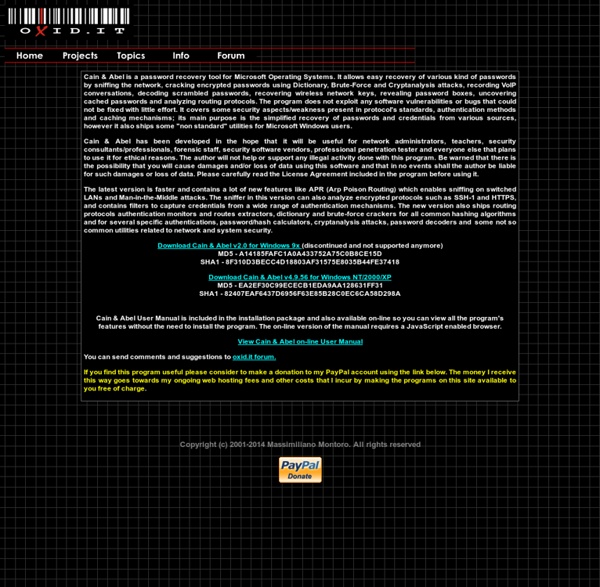How to hide files in JPEG pictures
If you’re looking to hide files on your PC hard drive, you may have read about ways to encrypt folders or change the attributes on a file so that they cannot be accessed by prying eyes. However, a lot of times hiding files or folders in that way requires that you install some sort of software on your computer, which could then be spotted by someone else. I’ve actually written quite a few articles on how you can hide files and folders in Windows XP and Vista before, but here I’m going to show you a new way to hide files that is very counter-intuitive and therefore pretty safe! Using a simple trick in Windows, you can actually hide a file inside of the JPG picture file!
The Infection File Popularity Contest - SpywareGuide Greynets Bl
Ever wondered exactly how people who enjoy putting malicious files into the wide blue yonder ensure their bundles of joy are as attractive as possible to those who would happily download them? Well, I came across this program today and thought it was worth looking into. It dips into what's hot and current in the world of free downloads then uses that to ensnare as many potential victims as possible. How do they do it? The above program helps, for starters. Fire it up and you see this:
Penetration Testing Tools - IT Best Practice
Penetration Testing is not a small task. Its required lots of practice and tools knowledge to get the right information and put all the information in Black & White. Tools here describe here are based on BackTrack Linux Version 5 Release 1.
Black Hat ® Technical Security Conference: USA 2010 // Archives
Caesars Palace Las Vegas, NV • July 28-29 Event AUDIO & VIDEO: The Source of Knowledge will be onsite to sell audio and video recordings of the Briefings sessions. Their booth will be located outside of the Fourth Floor (Promenade Level), Emperor's Ballroom, or click here to visit the SOK site: order media »
We Were Hacked! 8 Tips From A Hacking Victim For Minimizing Your Risk :... - StumbleUpon
Think you're safe from a cyberattack just because you're a small biz? Think again. Here's how to prevent a hacking. July 20, 2011
Tutorial: Cracking WEP Using Backtrack 3
Standard Disclaimer: This article is provided for informational purposes only. thew0rd.com and its affiliates accept no liability for providing this information. Please only use to test configurations on your own equipment. Accessing WIFI networks that do not belong to you is ILLEGAL.
How To Become A Hacker
Copyright © 2001 Eric S. Raymond As editor of the Jargon File and author of a few other well-known documents of similar nature, I often get email requests from enthusiastic network newbies asking (in effect) "how can I learn to be a wizardly hacker?". Back in 1996 I noticed that there didn't seem to be any other FAQs or web documents that addressed this vital question, so I started this one. A lot of hackers now consider it definitive, and I suppose that means it is. Still, I don't claim to be the exclusive authority on this topic; if you don't like what you read here, write your own.
In Unix, how do I change the permissions for a file
You can change file permissions with the chmod command. In Unix, file permissions, which establish who may have different types of access to a file, are specified by both access classes and access types. Access classes are groups of users, and each may be assigned specific access types. The access classes are "user", "group", "other", and "all". These refer, respectively, to the user who owns the file, a specific group of users, the other remaining users who are not in the group, and all three sets of users. Access types (read, write, and execute) determine what may be done with the file by each access class.
the web site computer criminals don't want you to read!
Hacker news, updated every few minutes --->> What else is new at this website, updated Jan. 12, 2010 Latest News on Cyberwar, updated Jan. 12, 2010 How to Break into Banks -- without Breaking the Law (would we lie to you?) See how Greggory Peck broke into a bank's computer system, legally.
Firesheep - codebutler
When logging into a website you usually start by submitting your username and password. The server then checks to see if an account matching this information exists and if so, replies back to you with a "cookie" which is used by your browser for all subsequent requests. It's extremely common for websites to protect your password by encrypting the initial login, but surprisingly uncommon for websites to encrypt everything else. This leaves the cookie (and the user) vulnerable. HTTP session hijacking (sometimes called "sidejacking") is when an attacker gets a hold of a user's cookie, allowing them to do anything the user can do on a particular website. On an open wireless network, cookies are basically shouted through the air, making these attacks extremely easy.
Ethical Hacker Network
"Ethical hacking" is the process of entering into a hacker's mindset in order to spot system vulnerabilities by performing typical hacks in a controlled environment. This book helps security professionals understand how malicious users think and work, enabling administrators to defend their systems against attacks and to identify security vulnerabilities. This is yet another great introduction to a topic for the Dummies Series. Chapter 1 – Ethical Hacking



